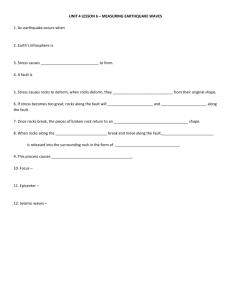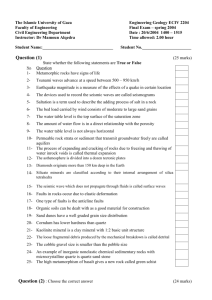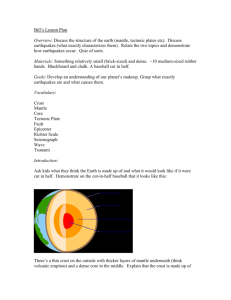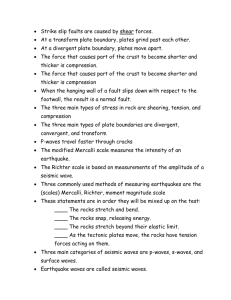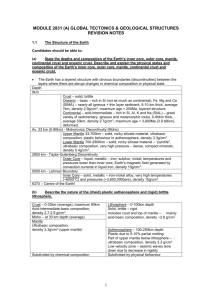Unit 4 – Earth`s Interior
advertisement
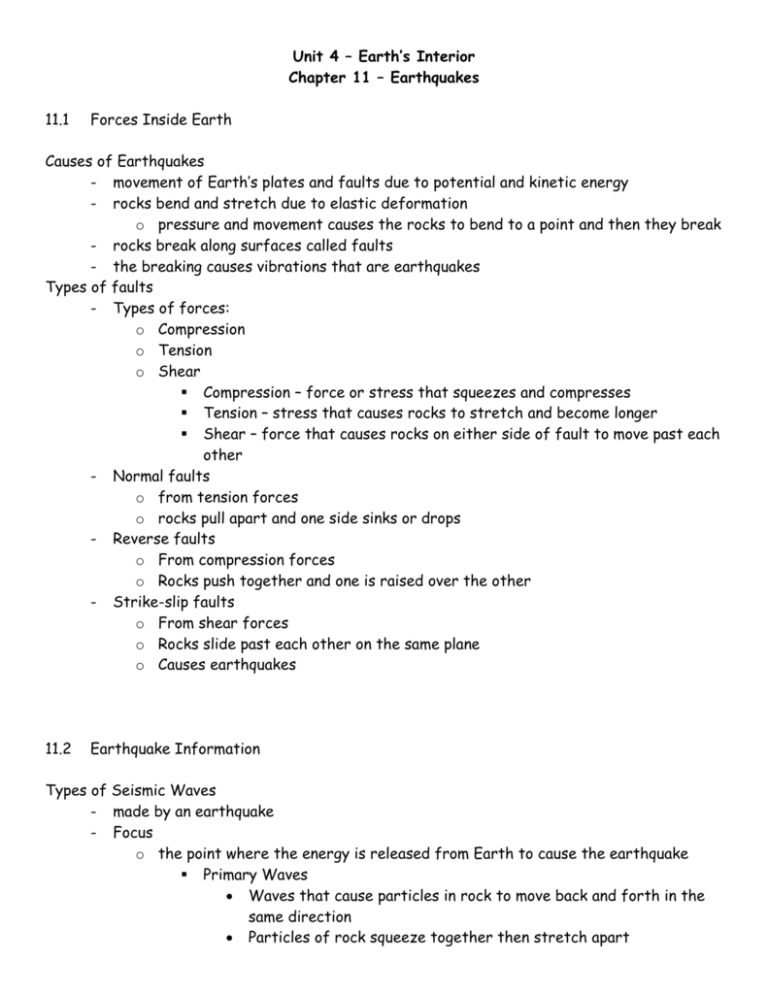
Unit 4 – Earth’s Interior Chapter 11 – Earthquakes 11.1 Forces Inside Earth Causes of Earthquakes - movement of Earth’s plates and faults due to potential and kinetic energy - rocks bend and stretch due to elastic deformation o pressure and movement causes the rocks to bend to a point and then they break - rocks break along surfaces called faults - the breaking causes vibrations that are earthquakes Types of faults - Types of forces: o Compression o Tension o Shear Compression – force or stress that squeezes and compresses Tension – stress that causes rocks to stretch and become longer Shear – force that causes rocks on either side of fault to move past each other - Normal faults o from tension forces o rocks pull apart and one side sinks or drops - Reverse faults o From compression forces o Rocks push together and one is raised over the other - Strike-slip faults o From shear forces o Rocks slide past each other on the same plane o Causes earthquakes 11.2 Earthquake Information Types of Seismic Waves - made by an earthquake - Focus o the point where the energy is released from Earth to cause the earthquake Primary Waves Waves that cause particles in rock to move back and forth in the same direction Particles of rock squeeze together then stretch apart - - - fastest Secondary Waves Causes particles in rocks to vibrate at right angles to the direction of the wave second Epicenter o The point on Earth’s surface directly above an earthquakes focus Surface waves Waves that travel along the surface of the Earth outward Cause most of the destruction of an earthquake Motion is up and down and side to side slowest locating the epicenter o all three types of waves do not travel at the same speed o primary is fastest, and surface is slowest o different speeds help find the epicenter o Farther apart the waves, the further the distance from the epicenter o At least 3 seismograph stations need readings Draw circles with their station as the center The radius is the distance of the wave from the station Three stations drawing circles – intersection is where the epicenter is mapping the Earth’s interior o different densities in Earth makes waves travel at different speeds o allows scientists to decipher what the interior is composed of due to those different speeds o four basic parts: inner core – solid mostly iron, and some oxygen, silicon, sulfur, or nickel outer core – liquid mostly iron mantle – solid and liquid silicon, oxygen, magnesium, and iron crust – solid thinnest, outermost Moho Discontinuity - waves speed up when they reach the crust - boundary between the crust and the mantle o speed up because they are passing through a denser layer of Earth o upper mantle Plasticlike Layer - primary and secondary waves slow down - less dense Shadow zone - area where no seismic waves are detected o secondary waves don’t pass through liquid o primary waves get bent o leaves and area blank Mantle Samples - magma contains some pieces of mantle that allows scientists to study the composition - volcanic or lava eruptions from vents, fissures, or volcanoes can bring up pieces of the mantle to study Meteorites - formed about the same time as Earth - can help us learn more about our composition - contain some of the same elements and minerals found in specimens on Earth
